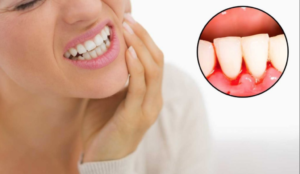How Do I Look After My Dental Health?
Quite honestly, you could write it on the back of a postage stamp:
- Keep your teeth clean
- Don’t eat sugar between meals
- Visit the dentist every six months
Of course, as with everything in life, the devil is in the detail. The following advice will go a long way towards preventing dental decay and gum disease, saving you from more serious (and costly) dental issues down the line. Here is a closer look at the best ways to keep your teeth and gums healthy.
1. Practice Good Oral Hygiene to Prevent Dental Decay and Gum Disease
The first step in looking after your teeth and gums is good oral hygiene. Here are some essential practices:
Brushing Properly is More Difficult Than It Sounds
Brushing your teeth twice a day is the foundation step in preventing dental issues. By brushing in the morning and before bed, you can effectively remove plaque, a sticky film of bacteria that builds up on teeth and gums. If left on your teeth, plaque is the main cause of both decay and gum disease.
- Brush for at least two minutes each time, ensuring you reach all surfaces of your teeth. Many people overlook the gumline, where bacteria tend to gather, so angle your toothbrush at 45 degrees to the gums.
- Brush methodically because if you don’t think about it properly, there will be areas that you habitually miss. I always recommend starting top left back on the outside of the tooth and working your way around to top right back on the outside, then do the same around the inside surfaces of the top teeth; repeat on the lower teeth. Each side of each tooth should have around two seconds of ‘brushing attention.’
Different Types of Toothbrushes
- Manual toothbrush – buy a soft or medium one with a small head so you can get the areas that are difficult to reach. Brushing the gumline is important with the brush angled at around 45 degrees, small circular motions, and one tooth at a time.
- Electric Sonic toothbrush – these are used the same way as a manual toothbrush, but the cleaning is enhanced by the ‘buzzing’ of the brush head. If you get one, make sure you still move it in little circles or back and forth. Research suggests that the ‘flick’ of the bristles performs a major role in loosening the plaque.
- Oscillating toothbrushes – these have round heads which swish back and forth, producing the ‘flick’ I mentioned before. They’re easier to use as they do all the work as long as you put them in the right place for long enough. Hold against the surface of the tooth, covering the gumline as well, for a few seconds then move to the next.
Electric toothbrushes are equipped with a timer to ensure that you do not go too fast.

Interdental Cleaning – Fiddly but Vital
Brushing alone does not clean between your teeth.
- Flossing: Traditional floss is effective and inexpensive, but it’s easy to do it badly. You need to use a fresh section for each tooth gap and slide it gently under the gumline to dislodge hidden plaque and food particles. Remember, each gap has two sides – you are cleaning the teeth, not waving the floss up and down the middle of the gap.
- Interdental Brushes: For those who find flossing tricky (nearly everyone), small interdental brushes are easier to manage and are great for wider gaps.
- Water Flossers: Water flossers are a gentle, convenient option, especially for people with sensitive gums or braces.
Using Mouthwash
Mouthwash comes in many forms and can be great, especially if you have had one recommended by your dentist for a specific problem. However, it does not make up for not keeping the teeth clean manually and will not solve your problems if you are struggling to keep them clean.
2. Don’t Eat Sugar Between Meals
Diet has a direct impact on your dental health. Foods and drinks you consume can either strengthen or weaken your teeth, depending on their nutritional content and sugar levels.
Limit Sugar Between Meals
Sugar feeds bacteria in the mouth, leading to the release of acids that break down enamel and cause dental decay. Frequent snacking on sugary treats or sipping sugary drinks increases your risk of both cavities and gum disease.
- Avoid sugary snacks between meals: Choose healthier snacks such as cheese, nuts, or fresh vegetables. Fruit is fine too, but better consumed as part of a meal as it tends to be acidic.
- Avoid fizzy or sugary drinks between meals: Sugar in drinks causes the same effects as sugary food. Fruit juices and fizzy drinks are also acidic – these can cause decay because of the sugar but also lead to erosion of the teeth because they are acidic.
Use a Toothpaste That Contains Fluoride
Fluoride is a mineral that strengthens tooth enamel and makes it more resistant to acid attacks that cause cavities. It’s an important part of preventing dental decay.
3. Visit Your Dentist Regularly
Regular dental check-ups are essential for long-term dental health. Seeing your dentist every six months (or as often as recommended) helps to catch problems early, ensuring they don’t develop into something more serious. There are also some problems that can occur in your mouth and can only be spotted by your dentist. Also, there are some medical issues that might show up there first.
Catch Problems Early
A routine dental exam allows your dentist to spot issues like plaque buildup, minor cavities, or gum inflammation before they get worse. Treating the early signs of dental decay or gum disease is usually simple and far less invasive than treating advanced problems.
- Professional cleanings: Plaque and tartar can build up over time, especially in hard-to-reach areas. A professional cleaning by a dentist or hygienist removes these deposits, keeping your teeth and gums healthy.
- Diagnose and monitor tooth wear and jaw issues: Regular examinations can also help catch early signs of wear caused by grinding or clenching, which can weaken your teeth and lead to sensitivity.
Screening for Oral Cancer and Other Conditions
Oral cancer and other conditions affecting the soft tissues of the mouth can often be detected during a routine dental check-up. Early detection is crucial for better outcomes, and your dentist is trained to spot changes in oral tissues that may indicate cancer or other serious health concerns.
- Early diagnosis for better outcomes: If any suspicious signs are found, your dentist can refer you for further testing or treatment before the condition worsens.
Conclusion
Looking after your teeth doesn’t require complicated routines—just consistency and a few key practices. By focusing on good oral hygiene, a balanced diet, and regular dental visits, you can significantly reduce your risk of dental decay and gum disease. Prevention is always better (and cheaper!) than treatment, so make these steps part of your daily routine to enjoy a healthy smile for years to come.
With proper care, you can keep your teeth strong and your gums healthy. And your regular visits to the dentist should be quicker and less costly.




